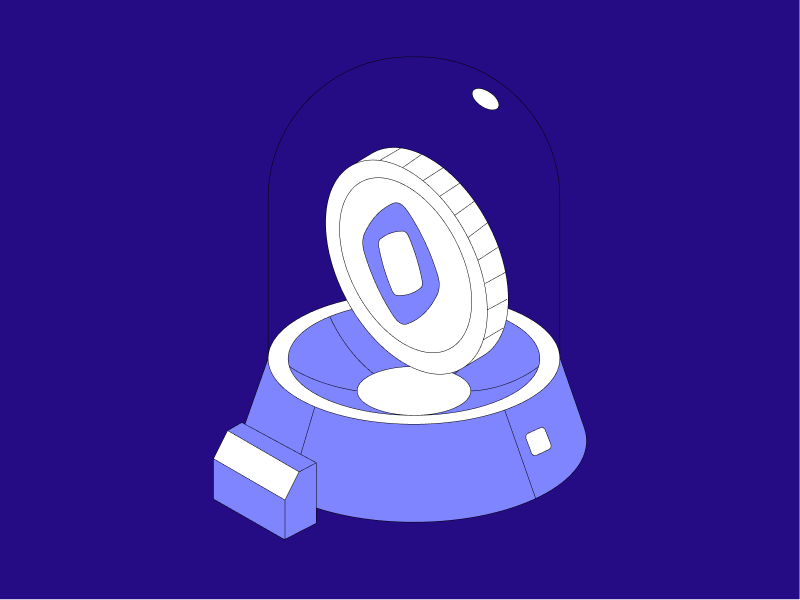Monad has been a hot topic of conversation in the crypto community, mainly due to the huge enthusiasm for its airdrop potential and its claim to be Ethereum’s new competitor. As an independent Layer-1 blockchain, Monad is here to address many of the technical limitations that networks like Ethereum and Solana face, from transaction speed to network efficiency. In this article, we will discuss what Monad is, the technology it uses, the potential of its ecosystem, and its future potential.
Article Summary
- 🚀 Monad is an EVM compatible Layer-1 blockchain with speeds up to 10,000 TPS and ultra-low transaction fees.
- 💼 Developed by Monad Labs (ex Jump Trading) with a total funding of $244 million.
- ⚙️ Features four key innovations: MonadBFT, parallel, asynchronous execution, and MonadDb.
- 🎯 The roadmap targets mainnet launch and ecosystem expansion by 2025.
- 🎁 MON airdrop opens October 14, 2025, with FDV estimated at $12 billion.
What is a Monad?
Monad is a new Layer-1 blockchain designed to be compatible with the Ethereum Virtual Machine (EVM) while delivering improved performance. This means that Monad can run the same smart contracts and dApps as on the Ethereum network.
Unlike Ethereum, Monad offers higher transaction speeds, lower fees, and better scalability. With the ability to process more than 10,000 transactions per second (TPS), Monad is ready to support various large-scale applications in the DeFi, GameFi, Metaverse, and other sectors.
Origin of the Monad Project
The Monad blockchain was developed by Monad Labs, a team of experienced professionals led by founders Keone Hon (CEO), James Hunsaker (CTO), and Eunice Giarta (COO). All three are former members of Jump Trading and founded Monad in 2022.
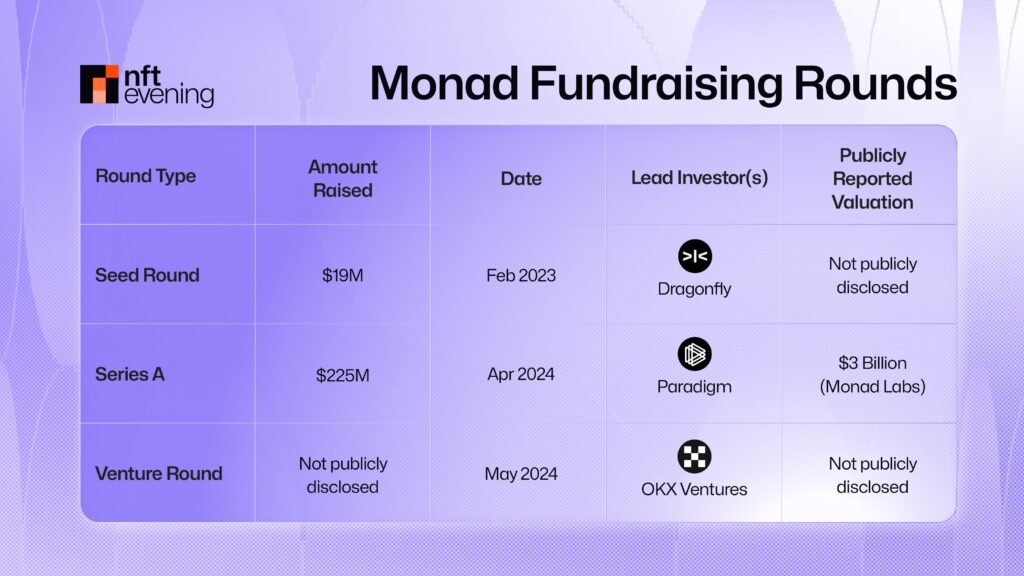
In February 2023, Monad secured $19 million in seed funding from Dragonfly Capital. The funding aims to build an EVM-compatible Layer-1 blockchain and develop parallel and asynchronous execution systems.
In April 2024, Monad received another Series A funding of $225 million led by Paradigm, with a valuation of around $3 billion. This round was also joined by Electric Capital, Greenoaks Capital, and Coinbase Ventures. A month later, OKX Ventures provided additional funding, bringing Monad’s total funding to around $244 million.
How does a Monad Work?
Monad achieves high performance by combining various new technologies to make blockchain faster, more efficient, and secure. The main innovations lie in the consensus system, transaction execution, and data storage management. These three elements are the foundation that significantly improves network performance.
As a result, Monad is capable of processing more than 10,000 transactions per second (TPS) with a block time of only 0.4 seconds, surpassing most other EVM networks. Here are the 5 main pillars of Monad:
MonadBFT: Fast and Secure Consensus System
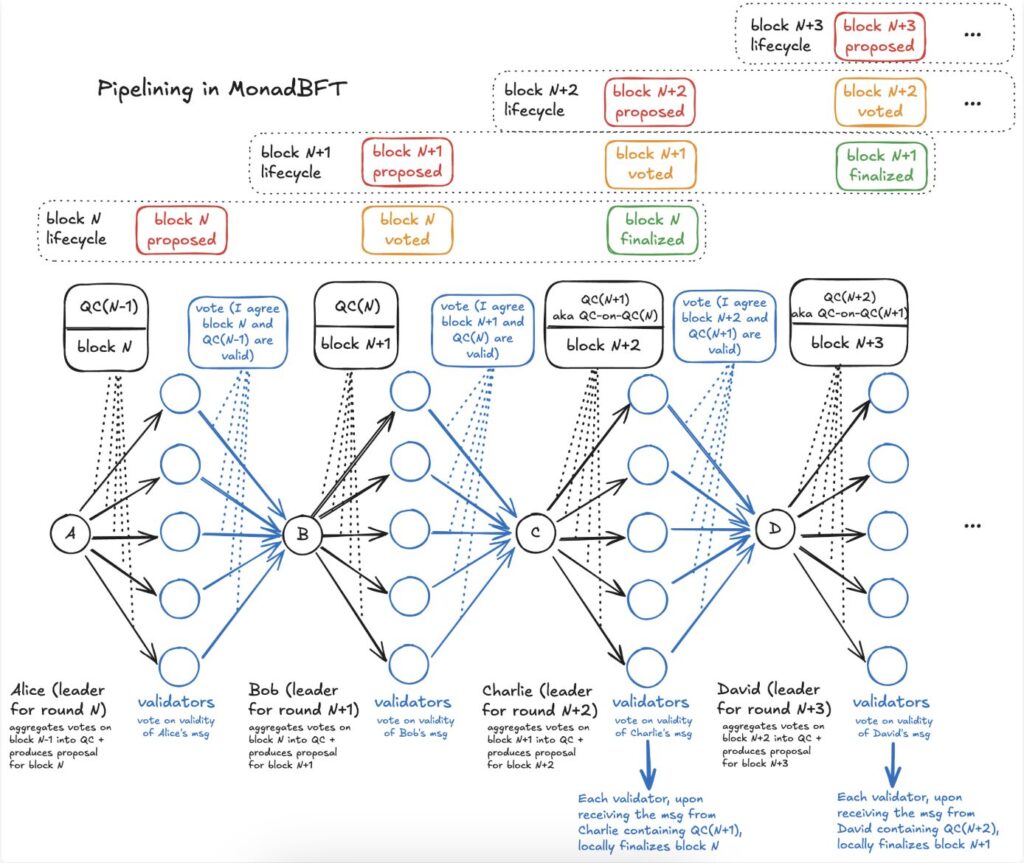
Monad uses a consensus system called MonadBFT, a more efficient version of the HotStuff algorithm. This technology speeds up communication between the network’s computers (nodes) and the new block creator, allowing the process of approving blocks to happen faster. If a block creator fails to submit a block on time, the system automatically switches to a backup mechanism, so the network can continue to run without interruption.
Asynchronous Execution: Concurrent Processes
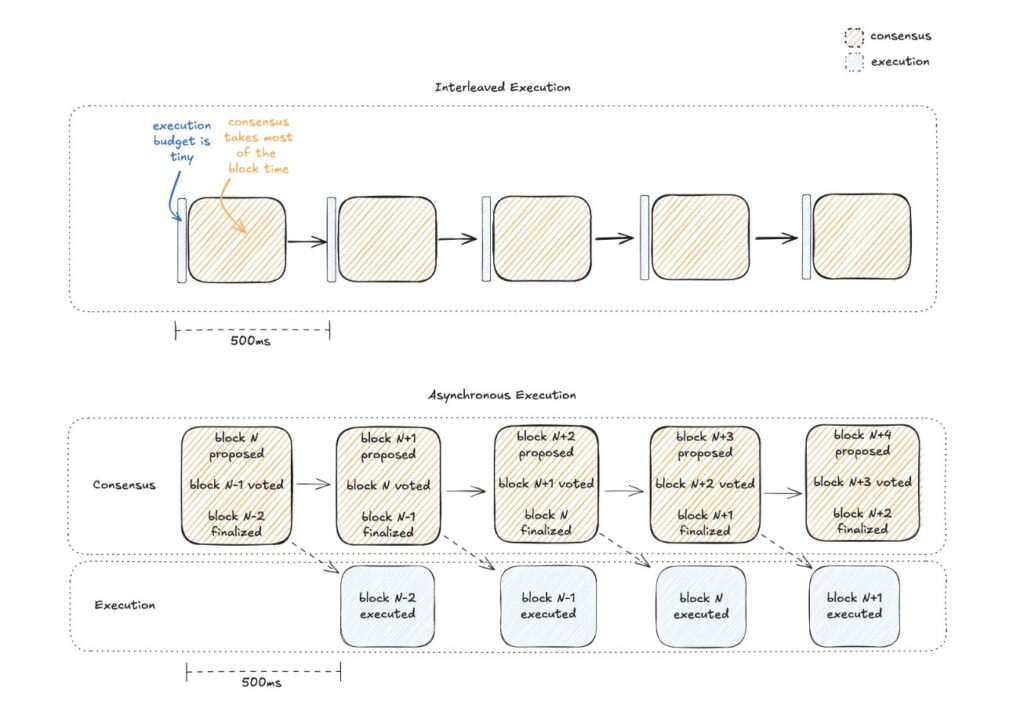
Usually blockchains determine the order of transactions and execute them sequentially. In Monad, the two processes are separated and run concurrently – one determines the order of transactions, the other executes them. This way, processing time is more efficient as both processes can use the full block time (about one second) without waiting for each other.
Parallel Execution: Multiple Transactions at Once
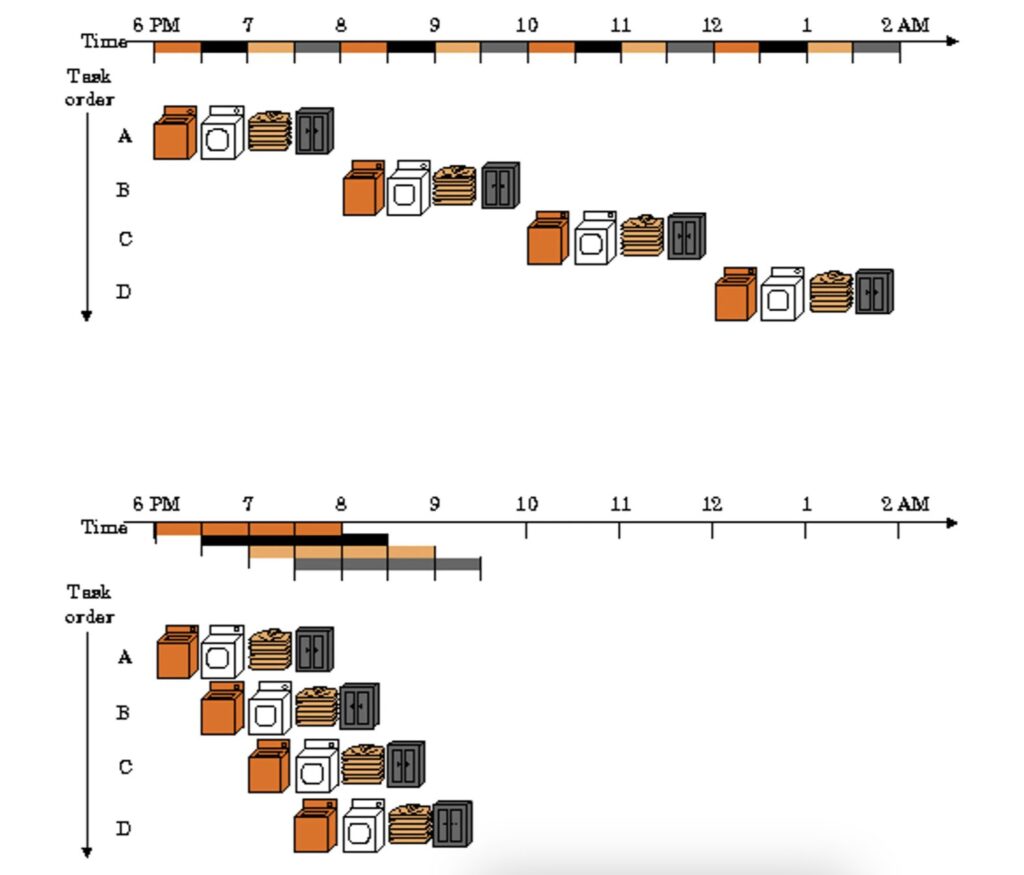
Unlike traditional blockchains that process transactions one by one, Monad can execute multiple transactions at once. This technique is called optimistic execution, where transactions are executed simultaneously, and if there is a conflict, only the problematic transaction is repeated. Monad also has a system that can predict which transactions are interdependent, so the order of execution can be organized more efficiently and quickly.
MonadDb: Super Efficient Storage System
Monad has a specialized storage system called MonadDb to store blockchain data in a fast and space-efficient way. Its data structure uses Patricia Trie, making it easy to search and manage.
MonadDb also supports asynchronous I/O, so there is no need to wait for one process to finish to run another. It can even write directly to SSDs without going through the usual file system, making it faster and lighter. In addition, MonadDb regularly tidies up and compresses old data to keep storage efficient.
Local Mempool
Generally, blockchains use a global mempool where all transactions wait to be processed. However, Monad introduces a different approach with local mempools managed by each validator. In this system, transactions are sent directly to the validator that will produce the next block, making the process of transaction deployment faster and more efficient in bandwidth usage .
The advantages of the local mempool system in Monad are:
- Faster and more efficient: Transactions are sent directly to the next validator, resulting in faster deployment and less bandwidth usage.
- Higher security: Access to unprocessed transactions is restricted, making front-running and sandwich attacks much more difficult.
- More optimized transaction execution: Users get more accurate transaction results with minimal slippage.
- A stable environment for developers: Providing a secure, consistent, and predictable system is essential for building complex DeFi protocols.
Advantages of Monad Technology
As mentioned earlier, Monad is here to address the limitations still found in other EVM-compatible blockchains. Through its technology design, Monad offers a combination of speed, efficiency, and high compatibility that makes it attractive to both developers and users. Here are its main advantages:
1. Full EVM Compatibility
Monad’s main advantage lies in its ability to be fully compatible with EVM. This allows developers to migrate Ethereum-based applications to the Monad network without the need to rewrite code. This makes the migration process faster and saves development costs.
In addition, full EVM support also enables the integration of Ethereum tools, libraries, and infrastructure directly into the Monad ecosystem. This means that existing projects on Ethereum can easily improve their performance on Monad while still utilizing the vast resources of the Ethereum network.
Monad has also been connected to 19 popular crypto wallets, including Phantom (with a dedicated domain monadtestnet.phantom.com), Backpack, OKX Wallet, Uniswap Wallet, Bitget Wallet, MetaMask, Rabby Wallet, and Fox Wallet, making it easier for users to interact with its ecosystem.
2. Faster Transactions and Lower Costs
Monad is specifically designed to address the scalability issues that are often the main challenge of EVM-compatible blockchains. Through parallel execution and deferred execution technologies, it can process thousands of transactions simultaneously in a much shorter time.
With high efficiency, the Monad network is able to reduce transaction congestion and speed up block confirmation. Gas fees can also be reduced to a very low level. Based on testnet data, the average transaction fee is only around $0.004-$0.007. This makes Monad a faster and more cost-effective choice than most EVM blockchains, including Ethereum.
Monad Comparison with Other Blockchains
Competition in the Layer-1 blockchain sector is intensifying with the presence of Ethereum, Solana, Avalanche, BNB Chain, as well as new entrants such as Aptos and Sui. Amidst this competition, Monad focuses on offering an EVM-compatible experience that is faster, more efficient, and cost-effective than other networks. Here’s how it compares:
| Aspects | Ethereum | Monad | Solana | BNB Chain |
|---|---|---|---|---|
| Consensus Mechanism | Proof of Stake | MonadBFT | Proof of Stake + Proof of History | Proof of Staked Authority |
| Scalability Approach | Layer 2, Sharding | Parallel + Asynchronous Execution | Proof of History + Parallel Execution | Layer 1 + Layer 2 Infrastructure |
| Transaction Speed (TPS) | ±15 TPS | ±10,000 polling stations (target) | ±1,000-1,100 actual TPS (65,000 theoretical) | ±180-414 actual TPS (2,222 theoretical) |
| Block Time | 12 seconds | 400 milliseconds (0.4 seconds) | ±400 milliseconds (0.4 seconds) | 750 milliseconds (0.75 seconds) |
| Transaction Finality | 12-15 minutes | 800 milliseconds (0.8 seconds) | ±12.8 seconds | ±1.875 seconds |
| EVM Compatibility | Yes | Yes (full bytecode compatible) | No (using SVM – Solana Virtual Machine) | Yes |
| Transaction Fees (Gas Fees) | Varies, often high | Very low (~$0.004-$0.007 on testnet) | Very low (~$0.00025 on average) | Low (~$0.01 on average) |
| Mainnet Status | Already active (Live) | Testnet (mainnet launch planned for late 2025) | Already active (Live) | Already active (Live) |
| Key Features | Decentralization & high security | Parallel and asynchronous execution, 400ms blocks | Fast and low cost | Low fees, Binance ecosystem |
MON Token Airdrop and Launch
As a high-performance Layer-1 project, Monad continues to capture the attention of the crypto community through recent developments ahead of the mainnet launch. From the development roadmap, to the launch of the official airdrop portal, to the analysis of MON token distribution by the community, each step shows Monad’s readiness to build a robust and decentralized ecosystem.
Monad Airdrop Portal Officially Opens on October 14, 2025
According to a recent announcement via a thread on X, Monad officially opened its airdrop claim portal on October 14, 2025, as a crucial stage ahead of its mainnet launch. Eligible users have until November 3, 2025 to verify their accounts and reserve their MON tokens.
According to the data, the number of eligible users is more than 230,000, including about 5,500 core community members who have supported the development of the project since its inception. The claims system uses Trusta AI’s Sybil detection technology to filter out fake or duplicate accounts for fairer token distribution.
When is MON Token Launching?
Although the airdrop portal is already open, the official date of listing and trading of MON tokens has not yet been announced by the Monad team. Based on activity on the Hyperliquid platform, the FDV value of MON tokens is estimated to be around $12 billion.
This claiming phase is an important stage before the mainnet launch and widespread adoption of the Monad ecosystem. In addition, Monad is yet to announce the tokenomics details of the MON token as well as other launch details such as vesting and token unlock.
MON Token Airdrop Distribution Estimation According to @CyphrGM Analysis
In the analysis shared by @CyphrGM on the X platform, he used an assumed FDV of $7 billion with a total supply of 100 billion MON, of which about 9 billion tokens (worth $630 million) were allocated to the community through airdrops. This estimate includes around 230,000 recipient wallets categorized into sixtiers based on community contribution and activity.
According to the simulation data, the top group “Community Last???” includes only 2% of wallets and is estimated to receive an average of 360,609 MON per wallet with a value of around $54,782. Meanwhile, the majority of users are in the lower tiers such as “Top 99%” and “Participation Award”, which earn between $547 and $274 per wallet respectively.
CyphrGM emphasizes that this is only an estimate based on internal calculations and not official data from the Monad team, but this analysis gives an initial idea of how the MON airdrop distribution could take place among the community before the mainnet launch.
Latest Projects and Predictions of NFT Monad
The Monad ecosystem is currently in a stage of significant growth, with a variety of new projects and innovations that point the way to a more efficient and scalable development of blockchain technology.
50 Best Projects in the Rising Monad Ecosystem
According to Monad Media via a thread on the X platform, the “Top 50 Monad Projects You Shouldn’t Miss” list highlights the rapid growth of the Monad ecosystem. This Layer-1 blockchain focuses on speed, efficiency, and full compatibility with the Ethereum Virtual Machine (EVM).
The projects listed cover a wide range of key sectors such as DEX, DeFi, AI, RWA, Prediction Markets, Consumer Apps, and NFTs, showing that Monad is now starting to build the foundation of an increasingly diverse and rapidly growing Web3 ecosystem.
According to Monad Media, the development stage of the Monad ecosystem is still in its early phase but is already showing great potential. This is driven by the many active builders who continue to innovate in various sectors.
Some of the prominent projects include Kuru Exchange, aPriori, Fortytwo, and Monaverse, which present solutions in decentralized trading, finance, artificial intelligence, and digital assets, respectively. “Monad’s ecosystem is still early – and these builders are shaping its future,” Monad Media wrote in its official post.
NFT Monad Future Predictions According to @mikeinweb on X
According to MIKEWEB through a thread on platform X, the NFT Monad market is expected to show a mixed pattern. Some well-known collectibles might achieve great success, while others could fail miserably. He noted that the outcome is difficult to predict, making diversification an important strategy for NFT collectors and investors.
MIKEWEB also highlighted that some users have dozens of whitelists (WL) of various NFT collections in the Monad ecosystem. This phenomenon also reflects the increasing interest in Monad NFTs as part of creative innovation in the blockchain world.
Start Crypto Investing at the Pintu
Now that you’re up to date with the Monad project and its ecosystem potential, you can start exploring other Layer-1 projects and EVM tokens through the Pintu app. All in one secure, easy-to-use app that is suitable for beginners and experienced investors alike.
Here’s how to buy crypto assets on Pintu:
- Enter the Pintu homepage.
- Go to the Market page.
- Search and select the crypto asset that you have analyzed before.
- Enter the amount you wish to purchase, and follow the rest of the steps.
Conclusion
As a new Layer-1 project, Monad offers a technology approach that focuses on transaction speed, cost efficiency, and full compatibility with EVM. Innovations such as MonadBFT, parallel and asynchronous execution, and the MonadDb system demonstrate the team’s efforts in building a more scalable and efficient blockchain. With funding support from major investors such as Paradigm and Dragonfly Capital, Monad has a strong foundation to continue its development until the mainnet launch.
The opening of the airdrop portal on October 14, 2025 is an important step ahead of the network’s official launch. Although the MON token is not yet listed on exchanges and the distribution details have not been finalized, the enthusiasm of the community shows considerable interest in the project. Monad’s future success will largely depend on technical execution, developer adoption, as well as the ability to build a sustainable ecosystem amidst the fierce competition of the Layer-1 blockchain sector.
Disclaimer: All articles from Pintu Academy are intended for educational purposes and do not constitute financial advice.
Reference:
- Backpack. Wen Monad Mainnet. Accessed October 21, 2025
- Bitget. Monad (MON): A New Layer-1 That Enhances the Speed and Efficiency in Crypto. Accessed October 21, 2025
- Coingecko. What Is Monad? The High-Performance EVM-Compatible Blockchain. Accessed October 21, 2025
- Finance Feeds. Monad Opens Airdrop Claim Portal Ahead of Mainnet Launch. Accessed October 21, 2025
- NFT Evening. Is Monad a Good Investment in 2025? Accessed October 21, 2025
